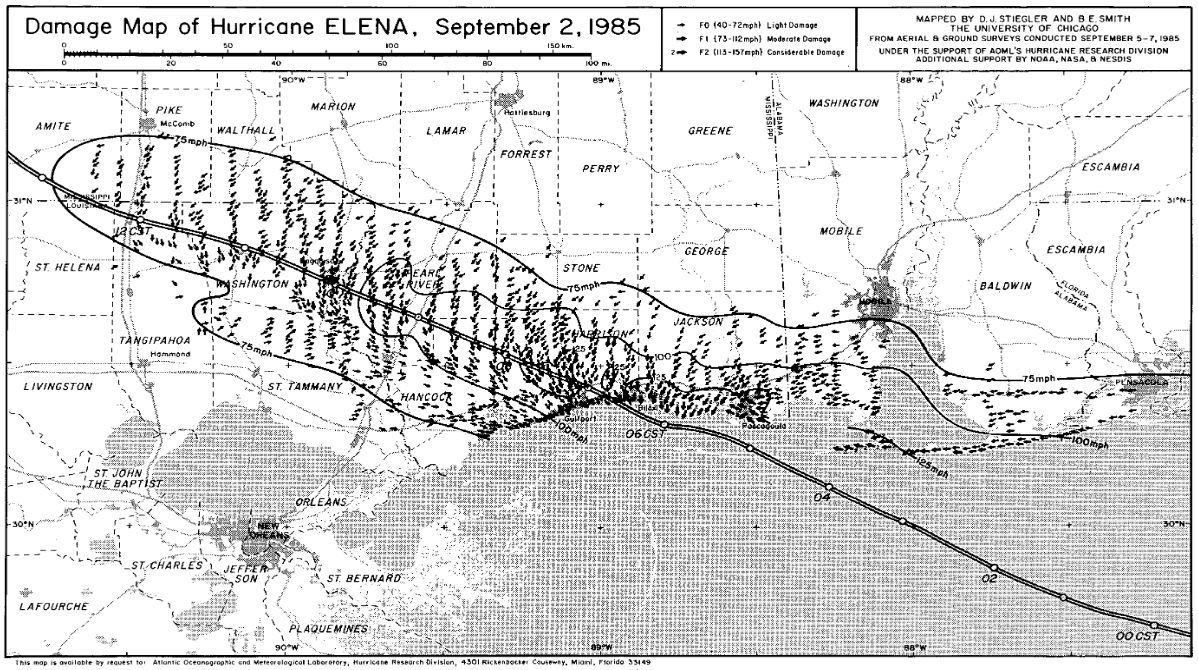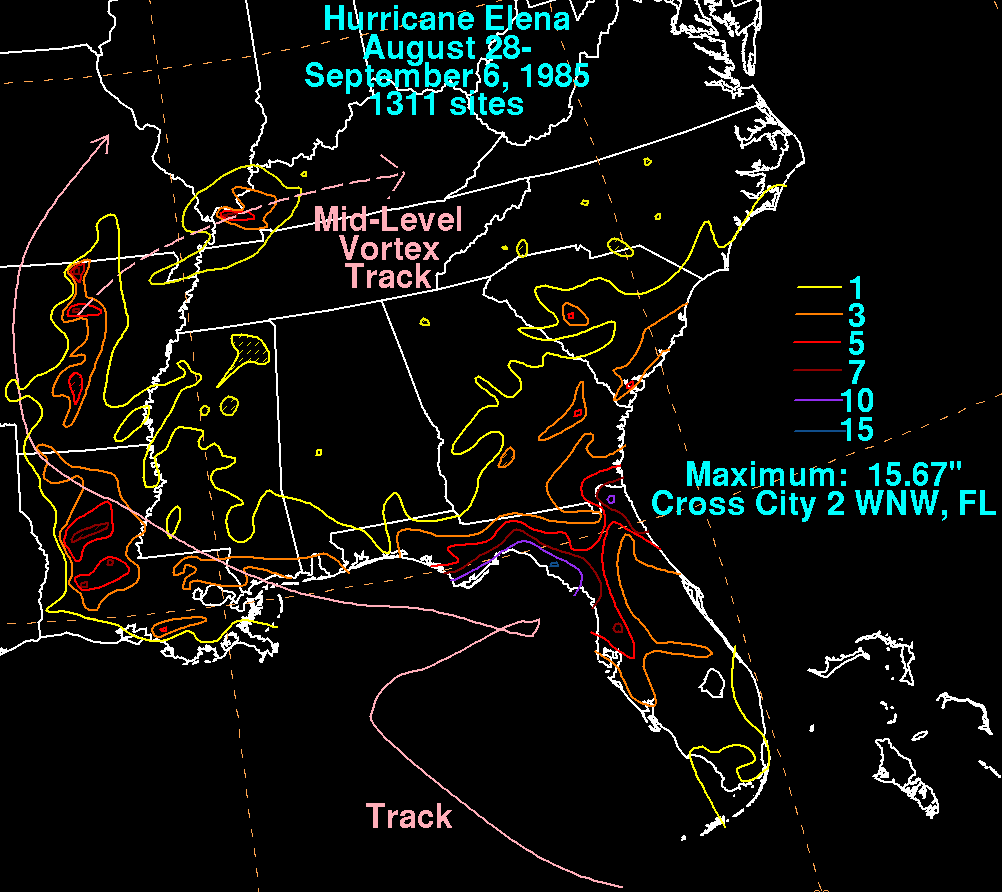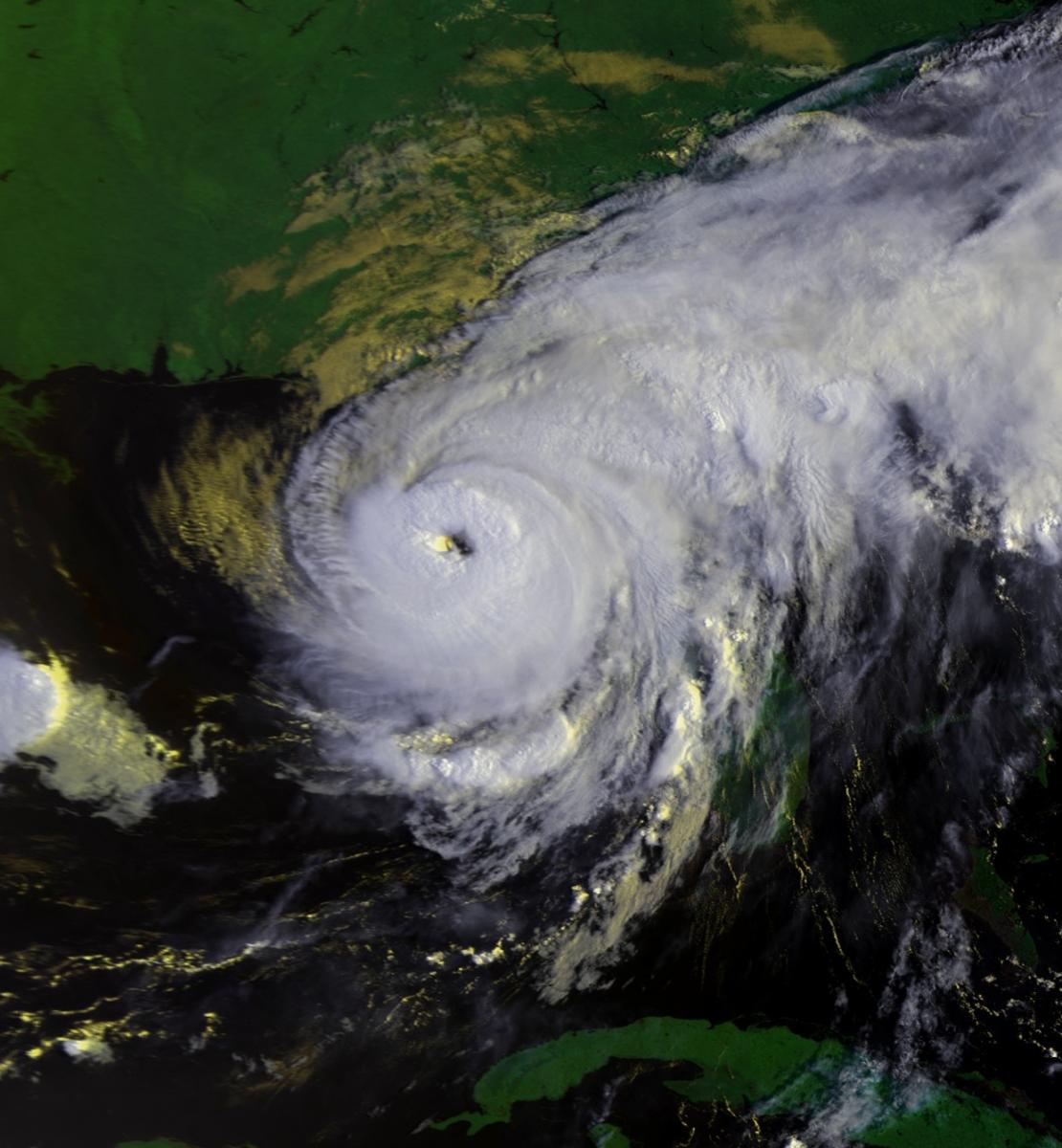Making landfall in September of 1985, Hurricane Elena was one of the most unpredictable tropical weather events in the United States. Elena repeatedly deviated from the projected hurricane path, making a two day anti-cyclonic loop in the Gulf of Mexico. The hurricane finally made landfall in Biloxi, Mississippi on September 2nd, 1985, resulting in one of the largest evacuations in United States history.

The National Academy Press published a scientific study on Hurricane Elena in their 1991 journal, Natural Disaster Studies Volume II, which describes the nature of the storm in detail.
In the beginning…
Satellite imagery spotted the early development of Hurricane Elena on August 23rd, 1985 as a well-organized cloud pattern north of the Cape Verde Islands. Fast westward motion (34 mph) and dry Saharan air surrounding the disturbance allowed for formation of a tropical cyclone. The tropical disturbance approached Cuba on August 27th, and reconnaissance aircraft measured wind speeds of 50-55 mph on August 28th.
The storm, now labeled Elena, quickly strengthened to a hurricane on August 29th. On August 30th, a mid-level anticyclone began development near the Rockies, with a ridge near the Great Plains. At the same time, a mid/upper-level trough began forming in the Mississippi Valley. On September 1st, the ridge extending from Oklahoma to the Great Lakes pushed eastward, causing the hurricane to stall and eventually revert to westward motion, moving it completely off track. With the present state of the art, many scientists believe the main aspects of motion of this hurricane should have been predictable.

Elena’s landfall characteristics, such as wind speed, were difficult to collect due to power outages and anemometer failure. Elena made landfall as a category 3 hurricane. At Point Biloxi, Mississippi, wind speeds hit 122 mph. Although the storm made a direct impact with Biloxi, the storm also caused reasonable wind damage to the east and west of the eye. In Bay Saint Louis, Mississippi, winds reached 96 mph. The coast of Alabama and Florida also saw decent wind speeds. Dauphin Island, Alabama, recorded a peak wind speed of 122 mph. The Pensacola Naval Air Station had a peak gust of 84 mph.
Tides were generally 3 to 6 ft above normal along the coast from Grand Isle, Louisiana, to Sarasota, Florida. The maximum storm surge occurred near Apalachicola, Florida at 10 feet above sea level. The coastlines of Mississippi and Alabama saw an average surge around 6-8 feet. If the angle of impact on the coast had been larger, the storm surge magnitude would have likely been greater. Elena was relatively dry compared to other hurricanes, records averaging less than 5 inches of rainfall. The maximum reported rainfall occurred in Apalachicola, Florida, with 11 inches of rain. Several tornadoes formed in central Florida when Elena stalled off the west coast.
Although there were not many fatalities associated with the storm, widespread damage occurred to several mobile homes northeast of Tampa which resulted in several injuries. At least a dozen tornadoes were reported in coastal counties of Mississippi as the eyewall crossed the coast. The lowest observed pressure on the coastline was 953 mb in Pascagoula, Mississippi. Reconnaissance aircraft flights of the National Oceanic and Atmospheric Administration recorded a pressure of 951 mb south of Apalachicola, Florida. The National Data Buoy Office recorded a pressure of 976 mb about 35 miles west of the landfall point.
Forecasting the Storm
The National Meteorological Center utilizes mathematical models to create calculations of atmospheric state and motion around the globe. Information from all available sources is used in preparing the final forecast. The track Elena followed was unusually complex. Elena had three important changes in course. Elena was initially on a north-northwest course toward Florida. At midday on August 30th (1200-1800 GMT),
Elena made an abrupt turn to the east. Stalled at midday on September 1st (1800 GMT), Elena executed a tight loop. After the completion of the loop, Elena resumed the track to the west-northwest. Overall, the best numerical forecasts for Hurricane Elena were the ones obtained from the new regional model (NGM). The high-resolution hurricane model (MFM) provided disappointing forecasts during this event. This prompted a re-evaluation of the model, which revealed an error had been made when converting the program to a new National Meteorological Center computer. The European Center for Medium-Range Forecasting produces global forecasts once a day, typically of excellent quality. Inadequate analyses of Hurricane Elena’s initial positions led to uncharacteristically poor forecast performance between August 29th and August 31st.
The center’s forecasts from September 1st onward are generally considered accurate. Hurricane forecasting would improve in accuracy by correcting the sparse data coverage in the Caribbean. The only upper-air observations from Cuba during Hurricane Elena came from the U.S. Naval Base at Guantanamo Bay. More data from Cuba could improve hurricane forecasting for the Caribbean, Gulf of Mexico, and the United States.

Storm Impacts
At the time, Hurricane Elena broke the record for the largest peacetime evacuation in United States history. About 1.5-million people were evacuated in Florida alone, some of them twice in four days (Tampa Bay Times, 2014). In total, about 2 million people evacuated. Although Hurricane Elena did not strike most of the areas it threatened, the hurricane served as a severe test to emergency preparedness systems. Many areas had residents evacuate, return home, and then were told to evacuate again. The region between Tampa Bay to Sarasota evacuated for the first time in many years.
Several of my family members recall Hurricane Elena’s impact and damage on the Mississippi Gulf Coast. My mother, Lt. Col. Cheryl Loper, and her parents, CMSgt John Loper and Mrs. Barbara Loper lived in Biloxi, Mississippi when the storm hit in 1985. As the storm changed course, my mother and grandmother both evacuated to Hattiesburg, Mississippi, while my grandfather stayed in Biloxi.
Although the evacuation was highly suggested, it was not mandatory. Hurricane Elena did not provide as strong of a evacuation incentive, considering it occurred before Hurricane Katrina, and many forgot the devastation brought on by Hurricane Camille in 1969. My grandfather rode out the storm, and initially he was not afraid. However, as the storm made impact with Biloxi, he could hear the pine trees snapping in the backyard. Pinecones rained down, and hit the roof so hard it sounded like cannonfire. He recalls putting on a motorcycle helmet and moving into the bathtub as a safety measure. As the eye moved through Biloxi, conditions temporarily calmed completely, then resumed again. Elena was a fast-moving hurricane. My mother was commissioned into the Air Force in May 1985, and was called to enter active duty in Colorado on September 5th. Hurricane Elena made landfall on September 2nd, 1985. She, however, was temporarily stuck in Hattiesburg due to storm conditions. She felt as if she was in more danger in Hattiesburg than in Biloxi, as she was staying in a rural section of the Pine Belt surrounded by pine trees she could hear snapping in half. The scariest part of the storm for my mother was the inability to communicate with my grandfather. At the time, cell phones were not commonplace, and electricity was out for virtually everyone on the coast. Since my mom quickly had to have an ID card made so she could go to Denver, she traveled back down to Biloxi the day after the storm. While trying to drive home, trees were scattered all down Highway 49. She frequently had to stop and wait for FEMA to collect the downed trees. In Biloxi, all of the stores were closed. There was no electricity or water for days. She spent her last few days in Biloxi picking up tree limbs on her street and in the yard. Thankfully, the worst damage to the house was the torn down backyard fence. She remembers the heat after the storm being almost unbearable, especially without running water and air conditioning.
Unfortunately, the true high temperature for September 3rd and 4th, 1985 in Biloxi is unavailable due to power outages during the storm. However, one temperature measurement was recorded at the Gulfport-Biloxi Regional Station. At 10 a.m. on September 4th, 1985, temperatures hit 87º F (Weather Underground, 1985), which is indicative of a hot and dry high-pressure system moving in.
Hurricane Elena caused massive damage on the Gulf Coast. The L.A. Times described the storm’s impacts in an article from September 3rd, 1985. Tidal surges flattened about 50 businesses and homes on the west end of Dauphin Island. In Biloxi, a tornado tore the roof from a senior citizens’ shelter, forcing paramedics to crawl through the wreckage to rescue 200 people. About 400 people who had sought shelter in Central Elementary School in Gulfport were left exposed to the storm when a tornado smashed through the school’s roof.
Glass from hotel windows shattered, even when barricaded by wood. Live oak, pine and pecan trees littered almost every road (Bearak and Kennedy, 1985). Hurricane Elena left more than $1 billion in damages in four Gulf Coast states over the 1985 Labor Day weekend. Only one person was confirmed killed in a storm-related accident, when a tree fell onto his car in Daytona Beach, Florida (Rowley and Hirsley, 1985).
Hurricane Elena proved the resilience and grit of Gulf Coast residents in times of natural disaster. The storm sent a wake-up call to storm prediction centers around the world. Weather patterns are not always intuitive, so it is crucial to the public’s safety that storm models are constantly improved and analyzed. Furthermore, it demonstrates the national need for enhanced weather prediction technology, which could easily be improved with more funding for meteorological advancements.
Works Cited
Bearak, Barry, and Michael J. Kennedy. “Storm Rips Into Coastal Mississippi : Damage Is Massive in 35-Mile Strip; Injuries Are Minor.” Los Angeles Times, Los Angeles Times, 3 Sept. 1985, articles.latimes.com/1985-09-03/news/mn-24239_1_minor-injuries.
“Gulfport-Biloxi Regional, MS History | Weather Underground.” Weather Underground , The Weather Company, 1985, www.wunderground.com/history/daily/us/ms/gulfport/KGPT/date/1985-9-4.
“Photos: Remembering Hurricane Elena’s Destruction Here in 1985.” Tampa Bay, Florida News, Tampa Bay Times, 1 Sept. 2014, www.tampabay.com/news/humaninterest/photos-remembering-hurricane-elenas-destruction-here-in-1985/2195638.
Rowley, Storer, and Michael Hirsley. “Elena`s Bill Of Damage: $1 Billion.” Chicago Tribune, 4 Sept. 1985, articles.chicagotribune.com/1985-09-04/news/8502270842_1_mississippi-hurricane-elena-national-hurricane-center.
Sparks, Peter, et al. “Hurricane Elena, Gulf Coast: August 29 – September 2, 1985.” Natural Disaster Studies Volume II, National Academy Press, 1991, www.nap.edu/read/1765/chapter/1.


Excellent article! I learned so much!